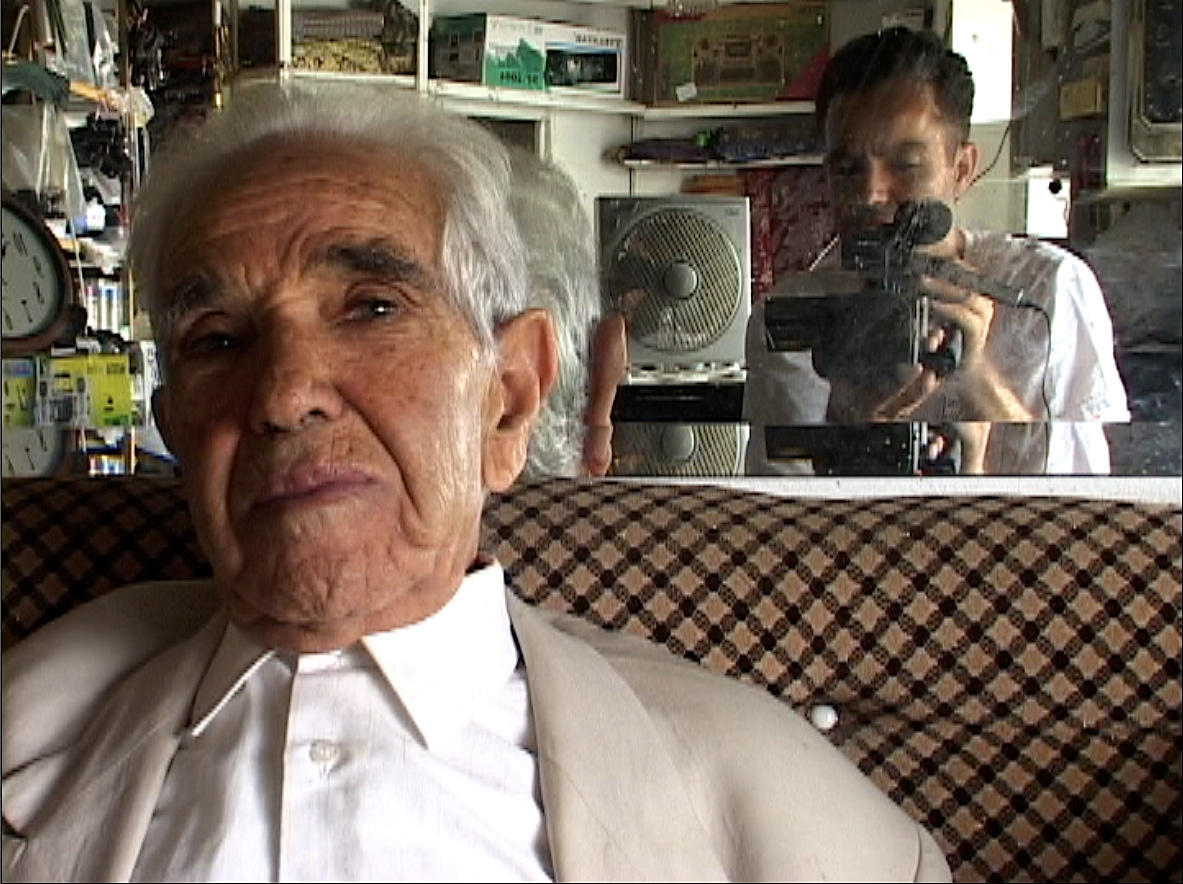
Throughout Hakim Belabbes’s latest film, Ashlaa (In Pieces, 2009), members of his family ask him why he insists on trying to make films.
It’s a fair question. A career as an independent filmmaker often entails a lifetime of personal and financial instability. The quest for financing is a purgatory. If you should manage to shoot something and finish it, distribution and profit sharing suck. There’s a brief glow of attention as the film is seen. Then you go back out and start again from scratch. So why make movies at all? Ashlaa poses this question alongside questions of life and death.
Belabbes grew up as one of twelve children in Boujad, a small town at the edge of Morocco’s Atlas Mountains, where his father Hamid ran a number of struggling businesses, including the town cinema. In an interview, the elegant silver-haired patriarch sits calmly in a barbershop chair, his son visible in the mirror behind him. After lamenting a lifetime of hard work, Hamid proceeds to deliver a browbeating that would resonate with the first generation of any and all diasporas: “You moved to America twelve years ago, and what do you have to show for it? You say you want to make films. But all you do is wait around for millions and waste your own money on airplane tickets. What you’ve done is zero. The most important things, you haven’t done yet.”
The director’s mother, sitting in a courtyard, preparing food, laughs at his filmmaking fixation. “You must be possessed, I’ll get you some incense.” But she sounds a similar theme. “It could take twenty years to make your film. A wife and children come with their own good fortune. Then you’ll be able to make your film.”
Those conversations were shot during a trip home in the 1990s. But Ashlaa proceeds from that trip to more recent footage, marking an interval during which the Chicago-based teacher and filmmaker got married, had a child, and, at last, made his films, including Khahit errouh (Threads, 2003), the story of an old man returning to his hometown to die, and Hazihi al-ayady (These Hands, 2008), an existential portrait of the town’s artisans, as documented by a local university professor.
Ashlaa, a fiercely intimate film, centers on Hamid Belabbes. Ten years after their encounter in the barbershop, father and son reunite. Frail and immobilized by illness, Hamid sits as a barber gives his fragile skin what may be his last shave. As Hakim makes the rounds of his extended Boujadi family, the neighbors’ houses are alive with rites and rituals.
A very old, very poor man squats on the street to make his ablutions with a small tin of hot water, then reenters a tiny one-room apartment to pray alongside his wife, who sits mute and distant on the floor. Yet another old man lies in a squalid house, resigned to death, talking with his friends. “I never hurt anyone.” His best friend agrees, then turns quietly to the camera. “I think he’s done. He’s had it.”
A father speaks of a son’s sudden disappearance thirty years earlier, the pain still fresh, as his surviving sons listen. Then one of them speaks haltingly of his own imprisonment and torture. The 1970s were Morocco’s dictatorial “years of lead,” and both cases can be assumed to have involved political repression. The son apologizes, unable to continue. The father asks his wife for a mirror so he can shave, and she reproaches him. How he can bring himself to look in the mirror? She hasn’t seen her own face since their son vanished.
Elsewhere, a tiny boy all dressed in white is circumcised. He howls, and the camera doesn’t blink (although you may). Equally graphic is the birth of Belabbes’s daughter Maya, caterwauling into her mother’s arms. Later Maya undergoes her own baptism ritual, awash in henna, after a sheep is sacrificed in the family courtyard before the wide eyes of “the little Americans” among the grandchildren.
Viewers unfamiliar with Moroccan family life might gape at the contrast between the seeming brutality of these everyday rituals and the sophistication, wisdom, and charm of the Belabbes family. Ashlaa takes its time, capturing the richness of their language, the startling articulacy of the elders, the tentative theology of the children, and their frequent, easy laughter.
How does a family stay afloat amidst a flood of rainwater, blood, tears, and disappearances? There’s hardly time for Hakim to show his father a few frames from his films before Ashlaa gathers to its inevitable climax — the dying itself elided by a shot of thunderous skies — as we see Hamid’s gravestone carried out of the house and to the graveyard, where the family, in shorts and t-shirts, piles stones and spreads palm fronds. A sister recounts a dream.
Three more years pass before Belabbes, his mother, and his camera return to visit the grave. It’s a scene of great delicacy, and the last, save for an epilogue from out of time — shot decades earlier, the night before eighteen-year-old Hakim left home for university, in which he says goodnight, and goodbye, to his father.
How do we go on, when everything around us — lives, words, memories — seem to be forever disappearing? Why make films? For Belabbes, as for Beckett, language itself seems the only answer. The language of film, though fragmentary and flawed, carries the dead forward, allows the living to carry on.